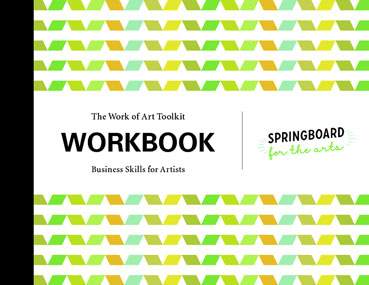5 tips for becoming a successful artist, both professionally and financially
By Laura Zabel
Making a living as an artist is an expansive, ever-evolving challenge. However, artists have found ways to make it work for centuries, pooling income from sales, patronage, teaching, grants, fellowships, and day jobs. New opportunities for artists have recently opened up through digital platforms, social media, and licensing, and knowing which business opportunities to take on can be overwhelming.
But, just as the practice of fundamental creative  techniques can make artists’ work better, artists can practice fundamental business techniques that will make their professional work stronger. Work of Art: Business Skills for Artists, a free digital toolkit from Springboard for the Arts in St. Paul, Minnesota, guides artists through those business practices. It covers career planning, marketing, legal considerations, business plans, and more. The toolkit is based on a series of professional-development workshops that have been delivered to more than 5,000 artists in 80 communities.
techniques can make artists’ work better, artists can practice fundamental business techniques that will make their professional work stronger. Work of Art: Business Skills for Artists, a free digital toolkit from Springboard for the Arts in St. Paul, Minnesota, guides artists through those business practices. It covers career planning, marketing, legal considerations, business plans, and more. The toolkit is based on a series of professional-development workshops that have been delivered to more than 5,000 artists in 80 communities.
The toolkit includes 12 units with activities and templates to use in planning your career goals and strategies, as well as a series of videos of artists sharing their experiences and best business practices. Here are five tips to get you started from the Work of Art toolkit; think of them as the business equivalent of stretching your canvases and sharpening your pencils before you get ready to start your masterpiece.
Make time to make art
You can’t make a living as an artist if you’re not making art. But life can be complicated, and distractions are everywhere, so making time for your work requires setting goals. Use the S.M.A.R.T. (simple, measurable, action, relevant, and time-bound) framework to clearly articulate your goals and get your art going.
Get your portfolio in order
Getting your work out into the world is a key part of making a living and a life as an artist. But what work should you be introducing? And how do you make sure that the work is right? Use the “Portfolio” module in the toolkit to clean up your artist statement, résumé, and work samples. The pieces you exhibit to the world should be your best work and representation of you now and historically.
Price your work right
Selling work can be a daunting challenge for any artist, and setting the price can seem like a high hurdle. Depending on your arts practice, you may have material or studio costs, labor costs for your working time, overhead costs for getting your work to market, and a profit that you want to make. If that challenge sounds daunting, don’t worry; the “Pricing” unit walks you through the steps to help you nail your price point.
Protect yourself
Artists face many issues around the use of images, copyright, intellectual property, and work for hire. The “Legal Considerations” module helps you get up to speed on legal terms and covers the questions you should ask to protect yourself in contracting. It also includes a sample cease-and-desist letter template, just in case you need to use it.
Find your circle
Whether your practice is solo studio time or community-engaged creation, you put in the work to make it better.  The same is true for your business practice, and it’s even better if you have a circle of support. Work with other artists to share information, opportunities, and support.
The same is true for your business practice, and it’s even better if you have a circle of support. Work with other artists to share information, opportunities, and support.
Laura Zabel is executive director of Springboard for the Arts, which operates Creative Exchange, a platform for sharing free toolkits and resources for artists and communities.


